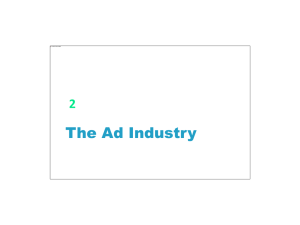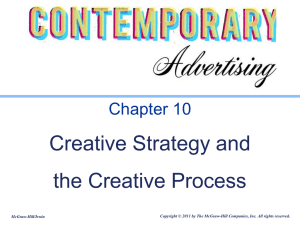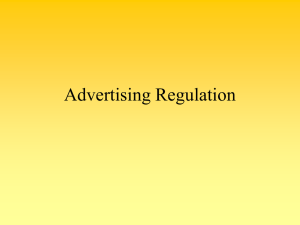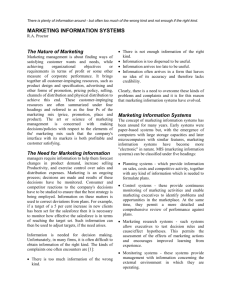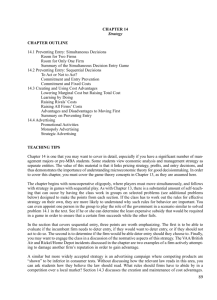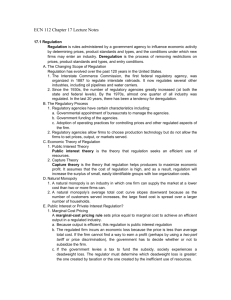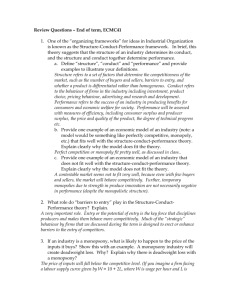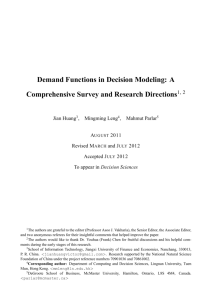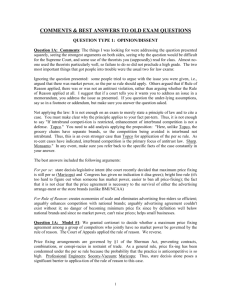Review/Homework Questions 2
advertisement
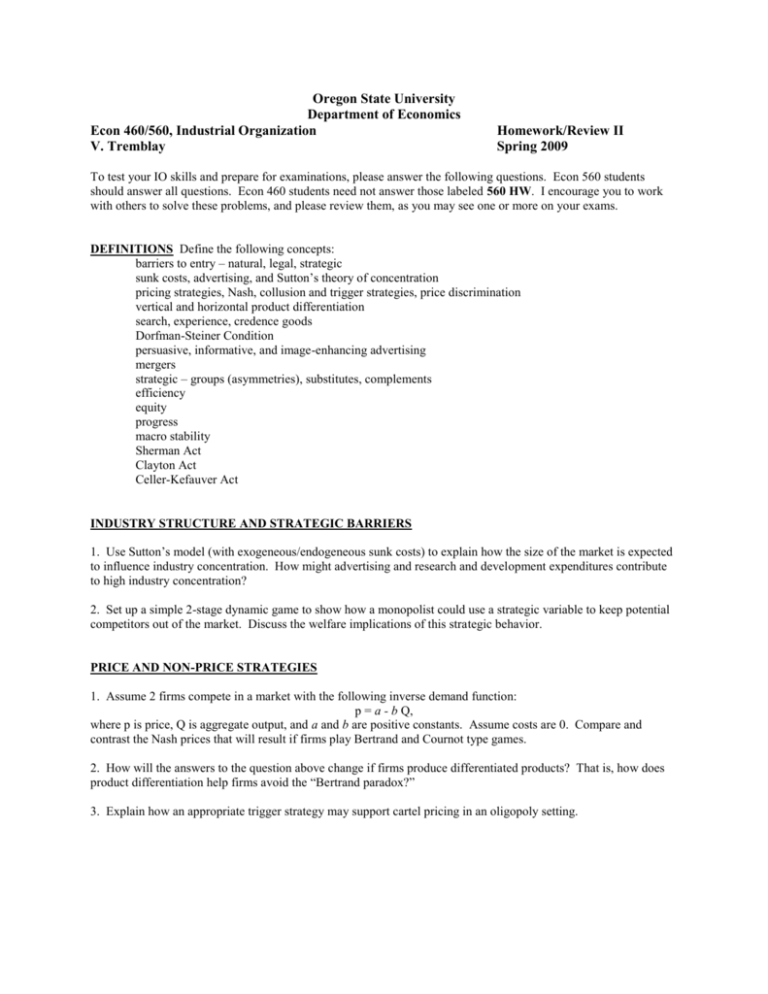
Oregon State University Department of Economics Econ 460/560, Industrial Organization V. Tremblay Homework/Review II Spring 2009 To test your IO skills and prepare for examinations, please answer the following questions. Econ 560 students should answer all questions. Econ 460 students need not answer those labeled 560 HW. I encourage you to work with others to solve these problems, and please review them, as you may see one or more on your exams. DEFINITIONS Define the following concepts: barriers to entry – natural, legal, strategic sunk costs, advertising, and Sutton’s theory of concentration pricing strategies, Nash, collusion and trigger strategies, price discrimination vertical and horizontal product differentiation search, experience, credence goods Dorfman-Steiner Condition persuasive, informative, and image-enhancing advertising mergers strategic – groups (asymmetries), substitutes, complements efficiency equity progress macro stability Sherman Act Clayton Act Celler-Kefauver Act INDUSTRY STRUCTURE AND STRATEGIC BARRIERS 1. Use Sutton’s model (with exogeneous/endogeneous sunk costs) to explain how the size of the market is expected to influence industry concentration. How might advertising and research and development expenditures contribute to high industry concentration? 2. Set up a simple 2-stage dynamic game to show how a monopolist could use a strategic variable to keep potential competitors out of the market. Discuss the welfare implications of this strategic behavior. PRICE AND NON-PRICE STRATEGIES 1. Assume 2 firms compete in a market with the following inverse demand function: p = a - b Q, where p is price, Q is aggregate output, and a and b are positive constants. Assume costs are 0. Compare and contrast the Nash prices that will result if firms play Bertrand and Cournot type games. 2. How will the answers to the question above change if firms produce differentiated products? That is, how does product differentiation help firms avoid the “Bertrand paradox?” 3. Explain how an appropriate trigger strategy may support cartel pricing in an oligopoly setting. 4. A monopoly sells in two countries, and resale between countries is blocked. The inverse demand functions for the two countries are: p1 = 100 - Q1, p2 = 120 - 2 Q2. Find the Nash prices in these two markets if the firm’s marginal cost is 30. 5. Discuss the main theories of advertising and advertising's possible impact on industry performance. 6. Discuss the relationships among advertising, product differentiation, and concentration. 7. (560 HW) Consider a monopolist who has two strategic variables: output (q) and advertising (A). Demand and cost conditions are: Inverse Market Demand: p = 260 - q + 9A - A2 Total Cost (TC): TC = 20q - A A. Given that the firm's goal is to maximize profit, identify the firm's objective function. B. Calculate the firm's first order conditions (note that there will be one for q and one for A). C. Calculate the profit maximizing q and A levels for the firm. D. Are the second order conditions met at the optimum? 8. If advertising is a sunk cost, discuss how advertising may signal product quality. 9. Find the Nash equilibrium in advertising (A) for duopolists (1 and 2) who face the following profit (π) functions: π1 = 1000A1 + bA1A2 – A12 π2 = 1000A2 + bA1A2 – A22 where b = 1 or –1. Would joint profits (i.e., π1 + π2) be greater if they formed a cartel? 10. Under what conditions is advertising likely to lead to higher and to lower Nash prices in an oligopoly market? 11. For a particular market, discuss how you would determine whether or not advertising is excessive from society's perspective. Be sure to include a discussion of their effects on consumer surplus, producer surplus, and other external costs/benefits. 12. Assume that two firms (A and B) compete in a market where entry is blocked. They play a single period game by simultaneously choosing their profit maximizing output. Demand and cost conditions are: Inverse Market Demand: p = 150 - Q, where Q = qA + qB Average (AC) and Marginal Cost (MC): AC = MC = 30 A. Calculate the profit maximizing output for each firm and the market price for this game. B. Assume that these firms merge into one firm (called AB), which causes AB's marginal and average cost to fall to 10. How would the equilibrium price and output change as a result of this merger? That is, calculate the new market equilibrium price and output levels and discuss how they have changed. C. Is society better or worse off as a result of this merger? Explain by comparing the impact of the merger on consumer plus producer surplus. D. Should our Antitrust Laws make such a merger illegal. FIRM EFFECTS & STRATEGIC GROUPS 1. According to Caves and Porter(QJE, 1977, p. 251): ...in most consumer goods industries a group of firms offering nationally advertised branded products typically coexist with a group of regional producers that offer a low or undvertisied product. Discuss the impact that this asymmetry would have on industry performance. How might you empirically test for the presence of such strategic groups in an industry? 2. Discuss the antitrust implications of a market where successful firms grow in size, causing industry concentration and economic profits to rise. How would your answer change if their growth were due to luck rather than success? CONSEQUENCES OF HIGH CONCENTRATION 1. Compare and contrast the following concepts of efficiency: technical, economic, productive, and allocative. Use an isoquant-isocost diagram to define a measure of technical and economic inefficiency. 2. Discuss how high concentration is likely to influence economic efficiency, equity, macro stability, and technological change. 3. Discuss the main problems with measuring and evaluating the economic performance of an industry. 4. Discuss, in some detail, how the event study methodology could be used to distinguish between the efficiency and the market power effects of the deregulation of an industry. 5. Discuss the main theories of advertising and its possible effect on industry performance. 6. Regarding Technological Change: A. Discuss the definition, measurement, causes, and consequences of technological change. B. Discuss the relationship between concentration and technological change. Summarize the empirical evidence on this issue. 7. Assume a market with the following demand and cost conditions: Inverse Market Demand: p = 120 - Q (Q = industry output) Average (AC) and Marginal (MC) Cost: AC = MC = 20 + 20/n (n = number of firms in the market) A. Calculate the competitive and monopoly solutions for this market (note that 20/n equals 0 when n approaches infinity-- as in perfect competition). B. Use a graph to identify consumer and producer surplus and efficiency losses due to monopoly. C. What role does the last term of the MC function (20/n) play in your discussion in part B above? Explain. ANTITRUST AND REGULATION 1. Explain the main economic motivations for the U.S. Antitrust Laws. 2. Explain the U.S. anti-merger laws. Have they been effective at promoting competition in the U.S. brewing industry? 3. During the 1990s, Walmart was found guilty of predatory pricing. According to the law, when should a firm loose a predatory pricing case? Explain. 4. Regarding a natural monopoly: A. Explain why a natural monopoly is normally regulated. B. Given the problem(s) discussed in part A, identify a socially optimal pricing policy. C. Why might a government agency use a different policy? Explain. 5. Does state licensing of Medical Doctors increase of decrease social welfare? Explain. 6. In the 1990s, Microsoft has faced antitrust litigation for bundling the sale of its Windows operating system with its internet Explorer software. That is, pc manufacturers had to install Explorer if they wanted to also install Windows. Because Windows is used in about 90 percent of all pc’s, the Department of Justice claimed that such behavior is anti-competitive. Do you agree or disagree with the Department of Justice’s claim? Explain.

